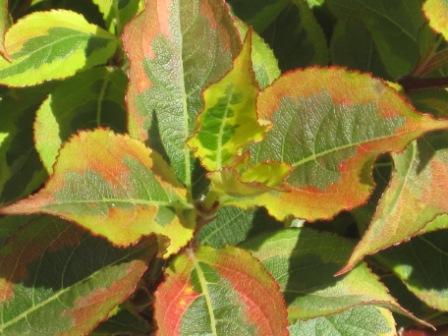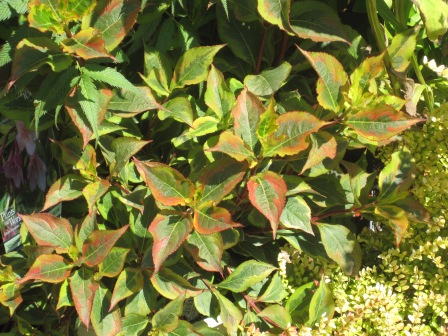Well, this was a tricky puzzle! Here’s a more complete picture of this interesting plant:

This, believe it or not, is a weigela – specifically, a patented cultivar named Kolmagira. You can see part of a tag in the lower left part of this photo:

As the patent description reads, this shrub possesses “…yellow green and dark green variegated leaves with purple-colored margins…”
Some of you guessed that the leaves might be variegated due to fall senescence, or disease, or drought stress – all very good guesses. And now I’m going to reveal one of my biases (yes, I am opinionated! I know you’re surprised!)
I dislike these types of cultivars because they look environmentally stressed and/or diseased. I’m a plant stress physiologist by training, and that’s just the way I look at abnormal leaf coloration. And on a more aesthetic note, do our gardens really need these tarted-up plants? Let’s discuss it!
Wow, i was way off, but i sure do enjoy learning! I am personally not one for all the variegations, contortions, & hybridizations going on in the industry right now. Especially since they rarely perform as well as the original. In most cases, the leaves, bark, flowers of the original species are just as beautiful or more beautiful than the newcomer and yet I fall prey at times to the newfangled cultivar. Echinacea anyone? I covet them every year and they never last more than 2. Thanks for the post Linda.
I’m with you on this one. It has taken me 20 years to develop an appreciation for chartreuse plants because they look nitrogen-deprived to me. Brown leaf edges look like leaf scorch. However, I do like my variegated Weigela when it is blooming with the green and yellow leaves and pink flowers.
Do our gardens really need these plants? I think our gardens need whatever makes us happy (providing, of course, that what makes us happy doesn’t take over the world). Gardening is about personal expression as much as anything else and I’m not going to tell someone they shouldn’t have a plant just because I don’t like it any more than I’d ask them to change their hair style because I don’t like the one they chose. I have two variegated Weigela in my garden (‘Variegata’ and ‘My Monet’) and I like that the foliage provides interest before and after the relatively short flower show.
Lisab, for the Echinacea, I assume you’ve tried everything so this probably won’t work in your neck of the woods, but I’ve had great success planting the new hot colored Echinacea in a site with good soil and good drainage. Dan Heims wrote a helpful article in Grower Talks last fall (Sept ’09 I think). It was aimed at growers, but the info is useful to homeowners as well.
I was thinking this looked just like the W. ‘Eyecatcher’ we have at the nursery in fall color. Didn’t have time to post a comment though. Do we need plants like this? Yes. Why? Because people like them and buy them. Yes it may look like it has a disease issue at times. (Weigela ‘Ghost’ looks like it has spider mites) But gardeners don’t know that, they just know that it blends well with their Miscanthus ‘Malepartus’ and Physocarpus ‘Summer Wine’.
For hybrid Echinacea, well drained soils are the key. They are like the E. paradoxa parent plant which hates heavy soil and dies due to too much winter moisture. They aren’t crazy fast like E. purpurea cultivars, but they are good growers when provided the right conditions. Mine perform very well here in WI.
Do we need them? I imagine that the hybidizers are surprised at some of the colorations in new seedlings. It is about profit and the unusual does get attention. As you have demonstrated, they do make great conversation pieces.
I’m not so fond of many of the cultivars that like stressed versions of the species; they make me feel as if something’s somehow ‘off’ in a garden, even if everything is healthy (Heuchera ‘Caramel’ makes me feel itchy). They certainly are marketable, though, even if they’re not my cup of tea. Mainly, I like the look of a thriving, life-filled garden, and when I see a plant that intentionally looks chlorotic or unhealthy it seems wrong. Nothing scientific here — just personal preference.
“Tarted up”?! So green-leaved plants are more modest? Since everyone’s stating their personal preferences here: I’m a fan of good performers, and within that parameter, the more fun with leaf color and variegation, the better. I don’t think I could garden without chartreuse, blue, burgundy, and variegated foliage. Wheee!
As Dr. Allan Armitage noted, no one walks into the garden center and asks “What’s old?”
I’m probably not a good one to ask. I think the leaf-miner trails in the Aquilegia look cool.
I don’t think I would use this plant in my garden but I could imagine this in a tropical look garden. Surrounded by dahlias, cannas and giant phormiums. I am a fan of Great Dixter, Rules are meant to be broken.
VG, I think that’s why I dislike this plant from an aesthetic perspective. The cool moist Pacific NW doesn’t have much in the way of naturally variegated foliage, so it seems off in Seattle landscapes. But in a tropical garden, I could see it.
I love your articles and am always willing to learn more from them! If you have the time could you please blog about how our gardens can become more wildlife friendly? Thank you
@LynnBay, great idea! I’ll make a note of it. Thanks for the idea.
I Just love this article. Love the plant.
As you have demonstrated, they do make great conversation pieces.